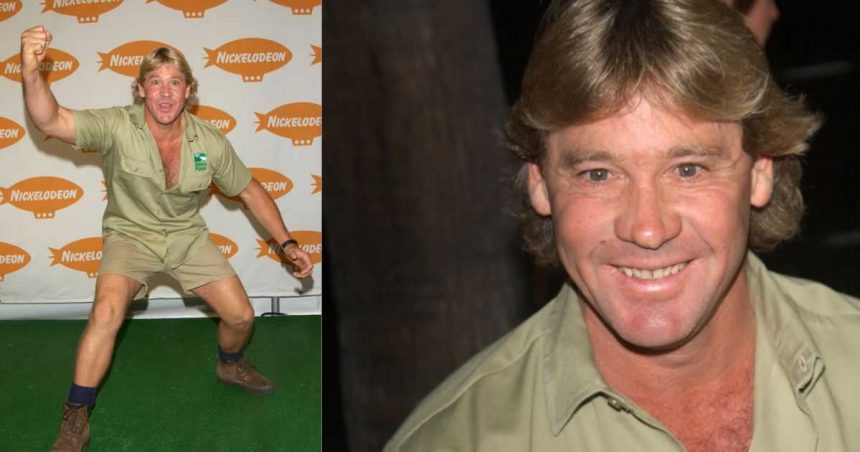Steve Irwin, fondly known as the “Crocodile Hunter,” was a legendary figure in wildlife conservation and a beloved television personality whose passion for nature was infectious. With his adventurous spirit and boundless energy, Irwin brought the wonders and perils of the natural world into the homes of millions of viewers worldwide. Beyond just entertaining, he devoted himself to environmental conservation, using his fame to champion for the protection of wildlife and habitats. Irwin’s hands-on approach, often placing himself in close proximity to some of the most dangerous animals on earth, was a way to educate the public about the significance of these creatures in the ecosystem.
Unfortunately, on September 4, 2006, the world mourned the loss of this vibrant conservationist in a tragic and rare incident. While filming in the Great Barrier Reef, Steve Irwin was fatally injured by a stingray barb piercing his chest. The sudden passing of such an influential figure shook not only his loved ones but also fans and environmentalists globally. The footage capturing the heartbreaking incident sparked ethical debates and raised questions about privacy, respect for the deceased, and the public’s right to information.
In this article, we seek to honor Steve Irwin’s enduring impact on wildlife conservation and explore the complex narrative of his untimely death.
The Serendipitous Alliance of Steve Irwin and Justin Lyons
The special bond between Steve Irwin and Justin Lyons began in a unique way during a beer commercial shoot in 1991. Their meeting in the remote landscapes of Queensland, Australia, marked the start of a collaboration that lasted over a decade. Lyons, a skilled cameraman capturing the essence of the wild, found in Irwin not just a subject but a kindred spirit dedicated to wildlife conservation. This chance encounter led to a partnership where they combined their talents and shared love for the natural world.
Creating Wildlife Documentaries
Steve Irwin’s charisma and fearless interactions with dangerous animals, along with Lyons’ cinematographic skills, resulted in early documentaries that laid the foundation for the iconic “Crocodile Hunter” series. These documentaries, which first aired in 1996, propelled Irwin to international fame. However, it was their joint commitment to conservation that truly defined their collaboration. Their documentaries served not merely as entertainment but as educational tools to raise awareness about preserving natural habitats and their inhabitants.
Irwin and Lyons mastered the art of blending education with entertainment, resonating with audiences worldwide. Irwin’s daring encounters with wildlife were not just for show but aimed at engaging viewers and delivering essential conservation messages. Lyons, behind the camera, captured these moments, showcasing the beauty and fragility of nature, making a compelling case for conservation without preaching.
Advocacy through Action
Their work extended beyond the screen as they actively participated in and supported conservation efforts. Irwin’s family’s Australia Zoo became a hub for conservation and research, drawing attention globally through their documentaries. Their approach was simple yet powerful: showcasing the wonders of nature to inspire a desire to protect it.
The alliance between Steve Irwin and Justin Lyons exemplifies the impact of united efforts in wildlife conservation. Their journey from a chance encounter to a powerful force in conservation and entertainment highlights the ability of passion and talent to create meaningful change. Their story not only sets the stage for subsequent events but also reminds us of their contributions to raising awareness about wildlife conservation on a global scale.
Chasing Tiger Sharks
Steve Irwin’s final expedition was a bold venture into the marine depths off the coast of Port Douglas, aiming to capture the majestic tiger sharks in their natural habitat. This mission was part of a series of shoots for “Australia’s Deadliest,” showcasing Australia’s formidable and often misunderstood marine creatures. The crew, well-versed in the unpredictability of wildlife filmmaking, spent weeks engaging with various marine life, including venomous stonefish and elusive sea snakes. Their strategy involved using bait to attract the sharks, highlighting the patience required in conservation efforts.
The expedition underscored Irwin’s and Lyons’ commitment to educating the public about these creatures, despite their dangerous reputations. Rooted in respect for animals, they sought to document their behavior without interference. This philosophy extended to interactions with all marine life, reflecting a profound understanding of ecosystem balance and each species’ role within it.
Steve Irwin’s Fatal Stingray Incident
A tragic moment unfolded during the expedition as the crew encountered a large stingray. Despite their familiarity with the creature, a defensive reaction led to a devastating injury to Irwin. The stingray’s barb struck with lethal consequences, transforming their educational endeavor into a fight for survival. The incident, a rare and heartbreaking occurrence, not only deeply impacted the conservation and television communities but also reminded us of the risks of close encounters with wild animals.
As the tragedy unfolded, Justin Lyons, witnessing the attack through his camera, captured the stark reality of the unexpected turn of events. In the face of adversity, the crew rallied…
(Continued in next comment)






